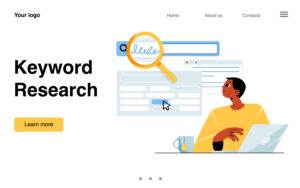So, you want to create a website that’s not just visually appealing but also conquers the digital realm through SEO, right? Well, you’re in the right place! In this digital age, a website is your online storefront, and making it SEO-friendly is like placing a giant neon sign that says, “Come on in!”
Table of Contents
But before we dive into the nitty-gritty details of how to make your website SEO-friendly, let’s address the big question:
Why Should You Care About SEO-Friendly Websites?
Great question! Let’s start by understanding why an SEO-friendly website is a game-changer:
- Visibility: SEO helps your website get found. When your site appears higher in search engine results, more people will discover it. It’s like having a prime location on a busy street.
- Credibility: High search engine rankings make your website look trustworthy. People tend to trust Google, so if it recommends your site, they’re more likely to check it out.
- Traffic: SEO brings in organic (free!) traffic. No need to pay for expensive ads when your website naturally attracts visitors.
- User Experience: An SEO-friendly site is often user-friendly too. It loads quickly, has a clean layout, and offers valuable content, which users love.
- Competitive Edge: If your competitors are investing in SEO and you’re not, guess who’ll grab the customers? Yep, your competition!
Now that we’ve established why SEO-friendliness is crucial, let’s jump into the main course!
Building Blocks of an SEO-Friendly Website
Creating an SEO-friendly website involves various elements working in harmony. Think of it like baking a delicious cake – you need the right ingredients and the perfect recipe. So, let’s explore these essential ingredients and how to mix them for a tasty SEO treat!
Keyword Research: The Foundation of SEO-Friendliness
Keywords are like the secret sauce in your SEO recipe. They’re the words and phrases people type into search engines when looking for information. To make your website SEO-friendly, you must:
Find the Right Keywords:
- Use tools like Google Keyword Planner or SEMrush to identify relevant keywords in your niche.
- Focus on long-tail keywords (phrases with 3 or more words) for a more targeted audience.
Understand User Intent: Think about what users want when they search for specific keywords. Are they seeking information, looking to buy something, or just exploring?
Use Keywords Strategically: Incorporate your chosen keywords naturally into your website’s content, headings, and metadata.
Pro Tip: Avoid keyword stuffing, which is like putting too much salt in your soup – it ruins the flavor (and your website’s ranking).
Content Creation: Serve Value on a Platter
Now that you have your keywords, it’s time to create content that people will love. Content is king in the world of SEO, so let’s whip up some fantastic articles, blog posts, or product descriptions!
High-Quality Content: Your content should be informative, engaging, and well-researched. Aim for the “Wow, I learned something new!” reaction from your readers.
Content Variety: Mix it up with different types of content, like blog posts, videos, infographics, and podcasts. This keeps your audience engaged.
Regular Updates: Google loves fresh content. Regularly update your website with new information to keep it relevant and appealing.
Pro Tip: Don’t forget to optimize your images and videos. Use descriptive file names and alt tags for images to make them SEO-friendly.
User-Friendly Design: Where Function Meets Fashion
Your website’s design isn’t just about aesthetics; it’s also about user experience. After all, if users can’t navigate your site, they won’t stick around, and that’s bad news for SEO!
Mobile Responsiveness: Ensure your website looks and works well on mobile devices. Google gives extra love to mobile-friendly sites.
Intuitive Navigation: Make it easy for users to find what they’re looking for. A clear menu and organized content are your best friends.
Page Speed: Nobody likes a slow-loading website. Compress images, minimize code, and use a reliable hosting service to speed things up.
Pro Tip: Test your website’s design and navigation with real users to gather feedback for improvements.
On-Page SEO: Tinkering Under the Hood
Now, let’s peek beneath the surface of your website and optimize it from within. This is known as on-page SEO, and it’s essential for boosting your website’s visibility.
Title Tags: Craft compelling and descriptive title tags for each page using your target keywords.
Meta Descriptions: Write enticing meta descriptions that summarize the page’s content and encourage clicks from search results.
Header Tags: Structure your content with header tags (H1, H2, H3, etc.) to make it more readable for both users and search engines.
URL Structure: Create clean and descriptive URLs for your pages. Avoid messy, long strings of numbers and symbols.
Pro Tip: Use schema markup to provide additional information to search engines, like star ratings for product reviews or event details.
Link Building: The SEO Social Network
Think of backlinks as your website’s endorsements. When other reputable websites link to yours, it tells search engines that your content is valuable and trustworthy. Here’s how to build those connections:
Quality Over Quantity: Focus on getting backlinks from authoritative websites in your industry. One high-quality link is worth more than a dozen low-quality ones.
Guest Blogging: Write guest posts for other websites, including a link back to your site in your author bio.
Content Promotion: Share your content on social media, forums, and communities to increase its chances of getting noticed and linked to.
Pro Tip: Monitor your backlinks regularly and disavow spammy or irrelevant links to maintain a healthy link profile.
Frequently Asked Questions (FAQs)
Before we wrap up, let’s address some common questions about creating an SEO-friendly website.
Q1: How long does it take for SEO efforts to show results?
SEO is a long-term game. You might start seeing some improvements in a few months, but significant results can take six months to a year or more.
Q2: Can I do SEO on my own, or should I hire an expert?
You can certainly learn and implement basic SEO strategies on your own, but for in-depth SEO, it’s often advisable to hire an expert or an agency.
Q3: Is SEO a one-time thing?
No, SEO is an ongoing process. Search engines continually update their algorithms, and your competitors are always vying for the top spot. Regular optimization is crucial.
Q4: Does social media impact SEO?
While social media doesn’t directly affect search engine rankings, it can drive traffic to your website and increase your online presence, which indirectly benefits SEO.
Congratulations! You’ve just graduated from the SEO School of Awesomeness. By now, you know that creating an SEO-friendly website involves a mix of keyword research, top-notch content, user-friendly design, on-page optimization, and strategic link building.
Remember, SEO isn’t a one-and-done deal. It’s an ongoing effort to stay ahead of the competition and maintain your digital presence. So, keep experimenting, learning, and adapting to the ever-changing world of SEO.
As you embark on your SEO journey, keep in mind that SEO is a bit like gardening. You plant the seeds, nurture them with care, and over time, you’ll see the beautiful blooms of success. So, go ahead, create that SEO-friendly website, and watch your online presence flourish!
Now, go conquer the digital world, one keyword at a time! 🚀




